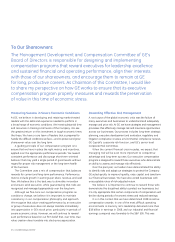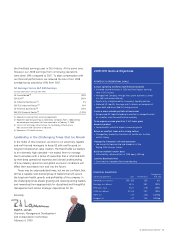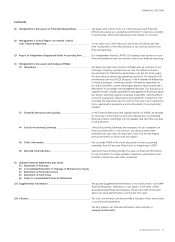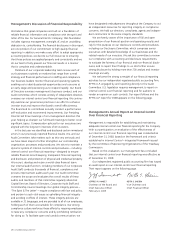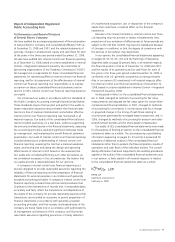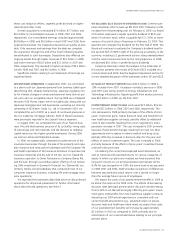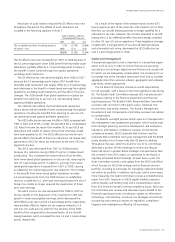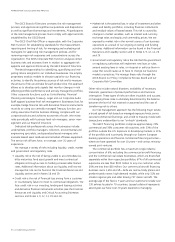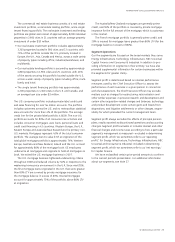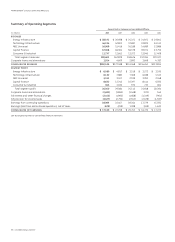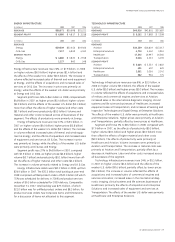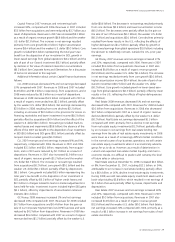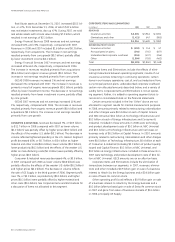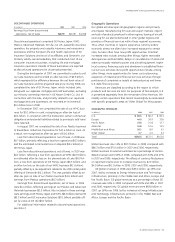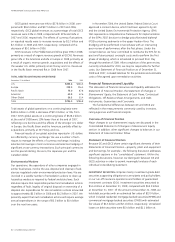GE 2008 Annual Report Download - page 24
Download and view the complete annual report
Please find page 24 of the 2008 GE annual report below. You can navigate through the pages in the report by either clicking on the pages listed below, or by using the keyword search tool below to find specific information within the annual report.management’s discussion and analsis
22 ge 2008 annual report
$521.2 billion, $456.4 billion and $389.0 billion in 2008, 2007 and
2006, respectively. GECS average composite effective interest
rate was 4.8% in 2008, 5.0% in 2007 and 4.6% in 2006. In 2008,
GECS average assets of $667.2 billion were 13% higher than in
2007, which in turn were 17% higher than in 2006. We anticipate
that our composite rates will continue to decline through 2009
as a result of decreased benchmark rates globally. However,
these decreases in benchmark rates will be partially offset by
higher credit spreads and fees associated with government
guarantees and higher cash balances resulting from pre-funding
of debt maturities and the need to maintain greater liquidity in the
current environment. See the Liquidity and Borrowings section
for a discussion of liquidity, borrowings and interest rate risk
management.
INCOME TAXES are a significant cost. As a global commercial
enterprise, our tax rates are affected by many factors, including
our global mix of earnings, the extent to which those global
earnings are indefinitely reinvested outside the United States,
legislation, acquisitions, dispositions and tax characteristics of our
income. Our tax returns are routinely audited and settlements of
issues raised in these audits sometimes affect our tax provisions.
Income taxes on consolidated earnings from continuing
operations were 5.5% in 2008 compared with 15.6% in 2007 and
16.9% in 2006. Our consolidated income tax rate decreased from
2007 to 2008 primarily because of a reduction during 2008 of
income in higher-taxed jurisdictions. This increased the relative
effect of tax benefits from lower-taxed global operations on the
tax rate. In addition, earnings from lower-taxed global operations
increased from 2007 to 2008. The increase in the benefit from
lower-taxed global operations includes a benefit from the 2008
decision to indefinitely reinvest, outside the U.S., prior-year
earnings because the use of foreign tax credits no longer required
the repatriation of those prior-year earnings.
Our consolidated income tax rate decreased from 2006 to
2007 as the tax benefit on the disposition of our investment in
SES and an increase in favorable settlements with tax authorities
more than offset a decrease in the benefit from lower-taxed
earnings from global operations, which in 2006 included one-time
tax benefits from planning to use non-U.S. tax net operating losses.
A more detailed analysis of differences between the U.S.
federal statutory rate and the consolidated rate, as well as other
information about our income tax provisions, is provided in
Note 7. The nature of business activities and associated income
taxes differ for GE and for GECS and a separate analysis of each
is presented in the paragraphs that follow.
Because GE tax expense does not include taxes on GECS
earnings, the GE effective tax rate is best analyzed in relation to
GE earnings excluding GECS. GE pre-tax earnings from continuing
operations, excluding GECS earnings from continuing operations,
were $13.7 billion, $12.8 billion and $11.7 billion for 2008, 2007
and 2006, respectively. On this basis, GE’s effective tax rate was
24.9% in 2008, 21.8% in 2007 and 21.9% in 2006.
Our principal pension plans were underfunded by $4.4 billion
at the end of 2008 as compared to overfunded by $16.8 billion at
December 31, 2007. At December 31, 2008, the GE Pension Plan
was underfunded by $0.9 billion and the GE Supplementary
Pension Plan, which is an unfunded plan, had a projected benefit
obligation of $3.5 billion. The reduction in surplus from year-end
2007 was primarily attributable to asset investment performance
resulting from the deteriorating market conditions and economic
environment in 2008. Our principal pension plans’ assets
decreased from $59.7 billion at the end of 2007 to $40.7 billion
at December 31, 2008, a 28.2% decline in investment values
during the year. Assets of the GE Pension Plan are held in trust,
solely for the benefit of Plan participants, and are not available for
general Company operations. Although the reduction in pension
plan assets in 2008 will impact future pension plan costs, the
Company’s requirement to make future cash contributions to the
Trust will depend on future market and economic conditions.
On an Employee Retirement Income Security Act (ERISA) basis,
the GE Pension Plan remains fully funded at January 1, 2009. We
will not make any contributions to the GE Pension Plan in 2009.
Assuming our 2009 actual experience is consistent with our
current benefit assumptions (e.g., expected return on assets and
interest rates), we will not be required to make contributions to
the GE Pension Plan in 2010.
At December 31, 2008, the fair value of assets for our other
pension plans was $2.4 billion less than the respective projected
benefit obligations. The comparable amount at December 31,
2007 was $1.6 billion. We expect to contribute $0.7 billion to our
other pension plans in 2009, compared with actual contributions
of $0.6 billion and $0.7 billion in 2008 and 2007, respectively.
Our principal retiree health and life plans obligations exceeded
the fair value of related assets by $10.8 billion and $11.2 billion at
December 31, 2008 and 2007, respectively. We fund our retiree
health benefits on a pay-as-you-go basis. We expect to contribute
$0.7 billion to these plans in 2009 compared with actual contri-
butions of $0.6 billion in 2008 and 2007.
The funded status of our postretirement benefits plans and
future effects on operating results depend on economic conditions
and investment performance. See Note 6 for additional informa-
tion about funded status, components of earnings effects and
actuarial assumptions.
GE OTHER COSTS AND EXPENSES are selling, general and adminis-
trative expenses. These costs were 12.9%, 14.2% and 14.3% of
total GE sales in 2008, 2007 and 2006, respectively.
INTEREST ON BORROWINGS AND OTHER FINANCIAL CHARGES
amounted to $26.2 billion, $23.8 billion and $18.9 billion in 2008,
2007 and 2006, respectively. Substantially all of our borrowings
are in financial services, where interest expense was $25.1 billion,
$22.7 billion and $17.8 billion in 2008, 2007 and 2006, respectively.
Average borrowings increased over the three-year period. Interest
rates increased from 2006 to 2007 attributable to rising credit
spreads. Interest rates have decreased from 2007 to 2008 in line
with general market conditions. GECS average borrowings were




